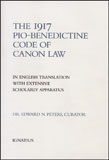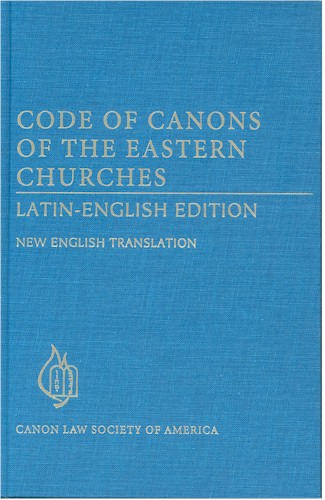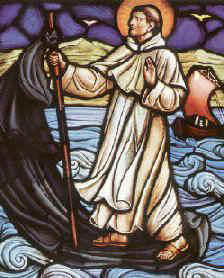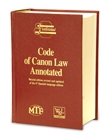|
To work for the proper implementation of canon law is to play an extraordinarily constructive role in continuing the redemptive mission of Christ. Pope John Paul II |
|
|
|
|
Resolution 1152 x 864 |
Updated 3 jan 2013 |
Review of E. Caparros, ed., Code of Canon Law Annotated, 2nd ed., (Wilson & Lafluer, 2004) 2066 pp. |
|
Edward Peters, Review of Caparros, ed., Code of Canon Law Annotated, 2nd ed., (2004), in Homiletic & Pastoral Review (Dec 2005) 73-75.
|
Series Gratianus (Wilson & Lafleur, Montreal: 2004) 2,066 pages, adapted from the 6th Spanish language edition of Código de derecho canónico, edicion bilingüe y anotada (University of Navarra). ISBN: 2-89127-629-9 or 1-890177-44-X. |
|
|
The 1983 Code of Canon Law took effect just over twenty years ago. During the first dozen years of its enforcement, English language explanations of the 1983 Code were dominated, nay, monopolized by the 1,100 page pan-textual commentary published by the Canon Law Society of America published in 1985. Known informally as the “big red book”, and a testament to (almost exclusively) American canonical talent, the [1985] CLSA Commentary immediately established itself as a powerful presence in canonistics. For all its strengths, though, the CLSA Commentary could not and did not represent the last word in canonical interpretation. Other voices would be needed with the passing years.
In the mid-1990s, two more English-language commentaries on the 1983 Code appeared. One was the product of the Canon Law Society of Great Britain & Ireland (though drawing on, in some areas, leading Canadian canonists). This thousand-page work immediately secured high regard among canon lawyers for being true to its title, Letter & Spirit (1996), and ably reflecting both aspects of modern canonistics. The other 1990s pan-textual commentary in English, a precursor in fact to the one being reviewed here, started winning its share of recognition more slowly, for it differed in some significant respects from the commentaries organized by the Americans and the British.
The original edition of Code of Canon Law Annotated (1993), although edited and released in Canada by a leading legal publishing house therein (Wilson & Lafleur in Montreal), was not originally an English language or even a culturally Anglo work: it was a translation of a Spanish canonical commentary first developed by the University of Navarra in Spain. This fact worked both for and against reception of the work in North America. The advantage of an English version of Code Annotated (a French version had been released in 1990) was that it made immediately available to English readers impressive scholarship from a leading continental canonical community, Spain. The disadvantage, though, was that some of the categories, issues, and lines of reasoning used by the Spanish did not relate well, or at least easily, to Anglo-American canonical approaches, suggesting at first a rather limited applicability to North American needs. There was, I think, some truth behind this perception, but over time, the value of the Spanish scholarship, beyond being adapted in some places to Anglo concerns by able Canadian editors, proved quite worth the efforts required to utilize the first edition of Code Annotated. It sold nearly 10,000 copies over ten years, a huge number by canonical standards.
Having proven the welcome that the “little red book” (Letter & Spirit being the “medium red book”) had won in English-speaking canonical circles, and a revised edition of the Spanish original coming available in 2001, the decision was taken to revise the English edition of Code Annotated. In 2004 that work became available and is the subject of this review.
Beautifully printed and sturdily bound, the revised edition of Code Annotated, still a “little red book” albeit of some 2,000 pages, features canon by canon glosses on nearly every norm of the 1983 Code. Latin originals and English translations (revised from the basic British version) of each canon are given, with commentary following immediately. A conscious effort has been made by the editors to trim materials that were of little canonical interest outside of Spain, and to augment the commentary with information more relevant and available to English-speaking canonists. While Rome’s official fontes (source footnotes to the 1983 Code) are not provided herein, there is more than ample textual citation to both pre- and, even better, post-promulgation canonical documentation as an aid to further research.
In contrast to the 1917 Code, the 1983 Code calls for considerable enabling legislation to be enacted at the episcopal conference level, and Code Annotated does an excellent job of assembling this particular legislation from numerous English-language conferences and organizing it in a useable appendix. The usual correlating tables to Pio-Benedictine and Eastern canon law are provided along with Latin-English versions of apostolic constitutions Divinus perfectionis, Spirituali militum, Pastor bonus and Universi dominici. The topical index is quite extensive.
While canonical commentaries are consulted overwhelmingly by canonists aware of the context in which these tomes arise and comfortable with the inherent limitations on their authority, given the happy resurgence of canonical interest among non-specialists, a few words should be said about the limitations that bear on any scholarly text of this sort. Briefly, one should recognize that, Code Annotated being the work of canonists qua canonists, and not of canonists qua legislators, administrators, or judges, one consults this volume for the opinions of the scholars it contains. Put another way, what one reads in Code Annotated need not, and usually should not, be taken as the only canonically compelling articulation that could be given an issue. Two examples should illustrate the point.
Canon law, after decades of disastrous post-Conciliar neglect, is once again being recognized as an indispensable component of ecclesiastical stability and pastoral effectiveness. Most bishops, pastors, religious superiors, and active laity, not being canon lawyers of course, will turn to concise and reliable commentaries on the 1983 Code in order to bring law to bear on their ecclesiastical work. The various American and British commentaries are a great service in this regard, but with Canada’s gift of Code Annotated, especially in this revised edition, English-speaking clergy and faithful alike will experience a valuable share of continental Europe’s approach to the many canonical issues that the Catholic world faces and that must be incorporated for progress toward a fuller understanding of the universal Church’s teaching, sanctifying, and governing missions.
|





